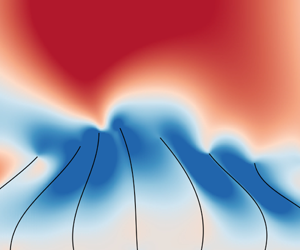Crossref Citations
This article has been cited by the following publications. This list is generated based on data provided by
Crossref.
Spinello, Davide
2020.
Coordination in Coupled Arrays of Stiff Filaments—Modelling and Simulation.
Mathematics,
Vol. 8,
Issue. 8,
p.
1282.
Lallemand, Pierre
Luo, Li-Shi
Krafczyk, Manfred
and
Yong, Wen-An
2021.
The lattice Boltzmann method for nearly incompressible flows.
Journal of Computational Physics,
Vol. 431,
Issue. ,
p.
109713.
Saleem, Najma
Munawar, Sufian
and
Tripathi, Dharmendra
2021.
Thermal analysis of double diffusive electrokinetic thermally radiated TiO2-Ag/blood stream triggered by synthetic cilia under buoyancy forces and activation energy.
Physica Scripta,
Vol. 96,
Issue. 9,
p.
095218.
Ma, Yuan
Mohebbi, Rasul
and
Sheremet, Mikhail
2023.
Heat transfer and fluid flow around starfish-inspired cylinder by immersed boundary-simplified thermal lattice Boltzmann method.
Engineering Analysis with Boundary Elements,
Vol. 146,
Issue. ,
p.
656.
Laborie, Emeline
Melchionna, Simone
and
Sterpone, Fabio
2023.
An operative framework to model mucus clearance in silico by coupling cilia motion with the liquid environment.
The Journal of Chemical Physics,
Vol. 158,
Issue. 9,
Akram, Javaria
and
Akbar, Noreen Sher
2023.
Electroosmotically actuated peristaltic-ciliary flow of propylene glycol + water conveying titania nanoparticles.
Scientific Reports,
Vol. 13,
Issue. 1,
Cui, Zhiwei
Wang, Ye
Zhang, Shuaizhong
Wang, Tongsheng
and
den Toonder, Jaap M. J.
2023.
Miniaturized metachronal magnetic artificial cilia.
Proceedings of the National Academy of Sciences,
Vol. 120,
Issue. 35,
Mao, Q.
D'Ortona, U.
and
Favier, J.
2024.
Hydrodynamic coupling of a cilia–mucus system in Herschel–Bulkley flows.
Journal of Fluid Mechanics,
Vol. 994,
Issue. ,
Musharaf, Hafiz Muhammad
Roshan, Uditha
Mudugamuwa, Amith
Trinh, Quang Thang
Zhang, Jun
and
Nguyen, Nam-Trung
2024.
Computational Fluid–Structure Interaction in Microfluidics.
Micromachines,
Vol. 15,
Issue. 7,
p.
897.
Cui, Zhiwei
Wang, Ye
and
den Toonder, Jaap M. J.
2024.
Metachronal Motion of Biological and Artificial Cilia.
Biomimetics,
Vol. 9,
Issue. 4,
p.
198.



